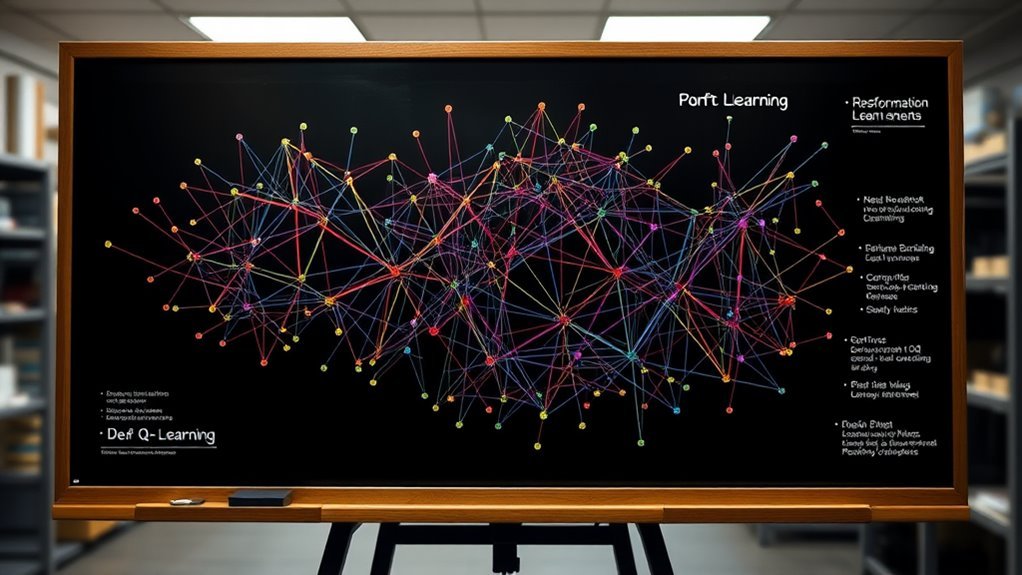You'll find that the best reinforcement learning algorithms, such as Q-learning, Deep Q-Networks, and Proximal Policy Optimization, are often determined by the specific problem you're trying to solve and the characteristics of the environment you're interacting with. You can use Q-learning for discrete action spaces, or opt for Proximal Policy Optimization for more adaptability. As you examine these options, you'll realize that each algorithm has its strengths and weaknesses, and that's where you'll start to reveal the nuances that'll help you make a well-informed choice.
Need-to-Knows
- Q-learning is a model-free algorithm.
- Deep Q-Networks stabilize with target networks.
- PPO optimizes policies with clipped objectives.
- DDPG suits continuous action spaces.
- DQN uses experience replay for efficiency.
Reinforcement Learning Basics
When interacting with their environment, you'll find that reinforcement learning involves agents learning to make choices based on the feedback they receive, which comes in the form of rewards or penalties tied to their actions.
This process is fundamental to Reinforcement Learning (RL), where an Agent operates within an Environment, taking Actions that lead to different States. The Agent receives Rewards for its Actions, which guide its decision-making process.
RL can be categorized into Model-Free methods, such as Q-learning, and Model-Based methods. You'll use these methods to develop a Policy that maximizes Rewards.
Model-Free methods, like Q-learning and Deep Q-Networks, learn directly from experiences, allowing the Agent to adapt to complex Environments.
Popular Algorithms Used
You'll find several key algorithms at the heart of reinforcement learning, including Q-learning, SARSA, Deep Q-Networks, Proximal Policy Optimization, and Deep Deterministic Policy Gradient. You can use these Reinforcement Learning algorithms to learn an ideal policy by interacting with an environment.
The Q-learning algorithm, for instance, learns the state-action pair values, while Deep Q-Networks (DQN) utilize experience replay to stabilize training.
Some popular algorithms include:
- Q-learning: model-free and off-policy
- Deep Q-Networks (DQN): uses experience replay and target networks
- Proximal Policy Optimization (PPO): on-policy method with a clipped surrogate objective function
You can apply these algorithms to various problems, including continuous action spaces using actor-critic methods like Deep Deterministic Policy Gradient.
Proximal Policy Optimization (PPO) allows for stable policy updates, helping you find the ideal policy. By understanding these algorithms, you can select the best one for your specific use case and improve your chances of learning an ideal policy.
Advanced Techniques Overview

Building upon the foundation of popular reinforcement learning algorithms, advanced techniques offer a more nuanced approach to complex problems. You'll find that methods like Proximal Policy Optimization (PPO) are particularly effective, as they stabilize policy updates using a clipped objective function. This makes PPO a top choice for high-dimensional spaces and practical applications.
Model-based methods, conversely, focus on improving sample efficiency by learning a predictive model of the environment, allowing for more knowledgeable decision making.
As you investigate advanced RL techniques, you'll encounter multi-agent reinforcement learning, hybrid methods, and model-agnostic meta-learning (MAML). These approaches allow you to tackle complex interactions between agents, combine the strengths of model-free and model-based methods, and adapt to new tasks quickly.
Implementation Considerations
Several key factors come into play as you implement reinforcement learning algorithms. You'll need to evaluate the trade-off between implementation complexity and performance. For instance, Actor-Critic methods like A2C and DDPG require separate neural networks for policy and value function representation, which can increase complexity but improve convergence speed.
When implementing RL algorithms, you should contemplate the following:
- Implementation complexity: algorithms like Proximal Policy Optimization (PPO) simplify policy updates, making them easier to implement.
- Sample complexity: the number of samples required to achieve good performance, which can be reduced using techniques like experience replay.
- Hyperparameter tuning: careful tuning is necessary to avoid instability during training, especially in algorithms like TRPO that use trust region optimization.
As you implement reinforcement learning algorithms, assessing these factors will help you choose the right approach for your problem.
You'll need to balance the complexity of the policy and value function representation, often using neural networks, with the need for efficient hyperparameter tuning to achieve good performance.
Key Algorithm Comparison

Reinforcement learning algorithms aren't created equal, and it's up to you to choose the right one for your problem. You'll need to reflect on the type of Learning you're doing, whether it's on-policy or off-policy, and the kind of action space you're dealing with. Reinforcement learning algorithms like Q-Learning, PPO, and DDPG are popular choices, but they have different strengths and weaknesses.
| Algorithm | Policy/Value | Action Space |
|---|---|---|
| Q-Learning | Value | Discrete |
| PPO | Policy | Discrete/Continuous |
| DDPG | Policy | Continuous |
When it comes to optimization, you'll want to think about how each algorithm updates its policy and value functions. PPO and DDPG are both known for their ability to handle high-dimensional spaces, while Q-Learning is simpler and more effective for large state spaces. By reflecting on these factors, you can choose the best algorithm for your Reinforcement learning problem and achieve effective optimization of your action and policy.
Future Research Directions
You're now looking to the future of reinforcement learning, and it's clear that developing hybrid models is a top priority. These models will integrate meta-learning and multi-agent techniques to improve adaptability and scalability in complex environments.
You'll need to evaluate scalability solutions to manage large populations of agents, allowing for effective collaboration and competition in multi-agent systems.
Some key areas of focus include:
- Improving interpretability to provide insights into decision-making processes and improve trust in AI systems.
- Developing robust algorithms capable of handling dynamic environments and ensuring stability and performance.
- Addressing ethical considerations in multi-agent interactions, promoting fairness, accountability, and transparency in collaborative AI systems.
Most-Asked Questions FAQ
Is PPO Better Than DDQN?
You'll find PPO's advantages, like stability and sample efficiency, often outweigh DDQN's strengths, making it a better choice for many applications, in spite of its implementation complexity.
What Are the Main Reinforcement Learning Algorithms?
You're exploring Q learning techniques, Policy gradient, and Deep Q networks, considering Actor critic methods, and Model based approaches for Continuous action spaces and Multi agent systems.
Is PPO the Best RL Algorithm?
You weigh PPO's advantages, like stability, against disadvantages, considering its applications, tuning, and performance, comparing it to A3C, to determine if it's the best fit for your project's needs.
How Do I Choose a Reinforcement Learning Algorithm?
You choose a reinforcement learning algorithm by evaluating problem complexity, measuring computational resources, and comparing exploration strategies, considering algorithm selection criteria and application domain suitability to guarantee stability.
Conclusion
You've learned about reinforcement learning algorithms and their applications. You're now equipped to choose the best one for your needs. You'll consider factors like complexity and performance, and you'll implement and compare them to achieve your goals. You'll keep exploring new techniques as you continue to work with reinforcement learning, and you'll stay updated on the latest developments.
